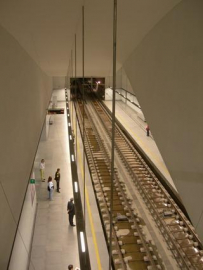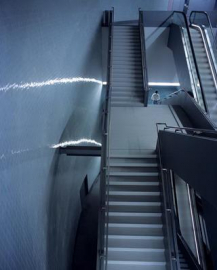Oporto Metro
The Metro and the City
The surface light rail system glides smoothly over ground on two steel rails, making hardly any sound.
The laying of the track is dictated by a closed circuit elevation value system complying with strict rules that have no subjective considerations.
The steel rails must be full embedded in the street pavement so that, in the vent of an emergency fire, service vehicles can pass from one side of the track to the other. The material used ranges from granite cubes to bituminous pavements or grass covering.
For acoustic reasons the rails are laid on a floating slab using steel components cushioned with rubber dampers.
The installation of the system meant that whole streets had to be destroyed and, as a result, their infrastructures also.
New sewage, rainwater, gas, electricity, telephone, cable TV, optic fibre cables and even oil pipe pipeline distribution networks have to coexist with the Metro light rail system being built which is achieved with multi-transport pipelines with access points every 20 metres.
But the problem of the surface metro does not exist only on the surface. There is also the sky to consider the catenary and the lighting systems. These can be suspended from a central post or from two lateral posts.
When the street are too narrow the catenaries and lighting are suspended from cables that are stretched from one building front to the other.
The problem is that such façades are either made of NUAGE glass or have a 7 cm-thick brick outer wall.
We work from the track outwards to the sides of the roads (the Metro track is always inflexible). Any space left over on the street is given over to other vehicles and parking where possible, and pedestrian pavement until the stoops are reached.
We can alternate materials and modify inclinations but the building stoops are sacred, it is like touching a stranger on his shoulder.
From shoulder to shoulder we modify elevation values, pavements, textures, pathways, road kerbsides, kerbstones, lamp-posts and trees. It is not that we want to alter the geography but Metro oblige.
When difficulties arise we speak to Transmetro or to Normetro, which then speak to the Metro, the town council, the parish council, the residents, and the tradesmen.
After being approved, we being to see streets that intersect and widen into squares, plazas, roundabouts, superfluous recesses, small courts, tree-lined plazas, parking on roadsides, and even boulevards Avenida da República: Gaia / Matosinhos.
Although this is not our vocation the Metro system builds places, nooks, joins cities, designs metropolises Gaia, Porto, Matosinhos, Maia, Trofa, Vila do Conde, Póvoa de Varzim and Gondomar.
Cities do not change of their own free will or by political decree but with the emergence of systems that they need to survive and develop.
It was thus with the Romans when at the crossroads of two routes they designed the Cardus and the Decomanus with the Forum in the centre.
It was thus in the Middle Ages when the Forum was replaced by Cathedral Square, built with the stones of the demolished temple.
It was thus in Baroque times with radiocentric axes connecting that Cathedral (now filled with gilt wood carvings) to the city gates.
It was thus in neo-classical times when the gates were demolished or redesigned and the spaces where the roads ended became squares flanked by convents.
It was thus in the 19th century with the railroad, when some convents became stations (São Bento).
It was thus in the 20th century with the surface light rail system (Matosinhos / Trindade).
It will be thus in the 21st century by which time the surface light rail system must be integrated into a planned system (enough of improvisations) creating a new urban landscape that cannot be postponed.
The country is small and we are few
, but I think we shall succeed.
Eduardo Souto de Moura








